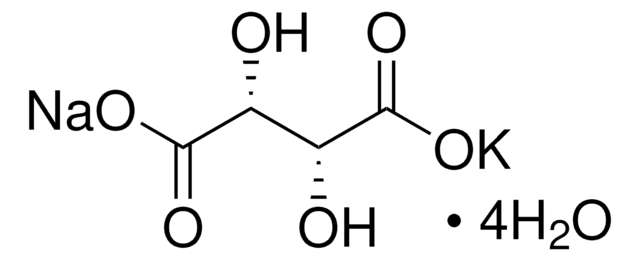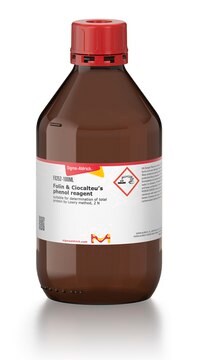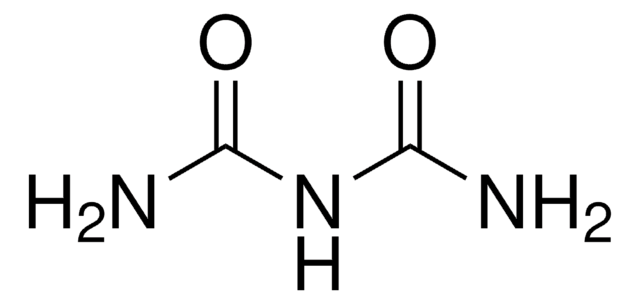36018
Fehling′s reagent I for sugars
reag. Ph. Eur., for determination of sugar, solution I: copper(II) sulfate
Sinonimo/i:
Copper(II) sulfate solution, Cupric sulfate solution acc. to Fehling, Cupric sulfate standard
About This Item
Prodotti consigliati
Grado
for determination of sugar
Livello qualitativo
agenzia
USP/NF
reag. Ph. Eur.
Concentrazione
17.6 g/L±0.1 g/L Cu
Densità
1.038-1.060 g/mL at 20 °C
Compatibilità
in accordance for application
applicazioni
food and beverages
general analytical
pharmaceutical (small molecule)
Stringa SMILE
[Cu++].[O-]S([O-])(=O)=O
InChI
1S/Cu.H2O4S/c;1-5(2,3)4/h;(H2,1,2,3,4)/q+2;/p-2
ARUVKPQLZAKDPS-UHFFFAOYSA-L
Cerchi prodotti simili? Visita Guida al confronto tra prodotti
Descrizione generale
Avvertenze
Warning
Indicazioni di pericolo
Consigli di prudenza
Classi di pericolo
Aquatic Acute 1 - Aquatic Chronic 2
Codice della classe di stoccaggio
12 - Non Combustible Liquids
Classe di pericolosità dell'acqua (WGK)
WGK 3
Punto d’infiammabilità (°F)
Not applicable
Punto d’infiammabilità (°C)
Not applicable
Scegli una delle versioni più recenti:
Certificati d'analisi (COA)
Non trovi la versione di tuo interesse?
Se hai bisogno di una versione specifica, puoi cercare il certificato tramite il numero di lotto.
Possiedi già questo prodotto?
I documenti relativi ai prodotti acquistati recentemente sono disponibili nell’Archivio dei documenti.
I clienti hanno visto anche
Il team dei nostri ricercatori vanta grande esperienza in tutte le aree della ricerca quali Life Science, scienza dei materiali, sintesi chimica, cromatografia, discipline analitiche, ecc..
Contatta l'Assistenza Tecnica.










